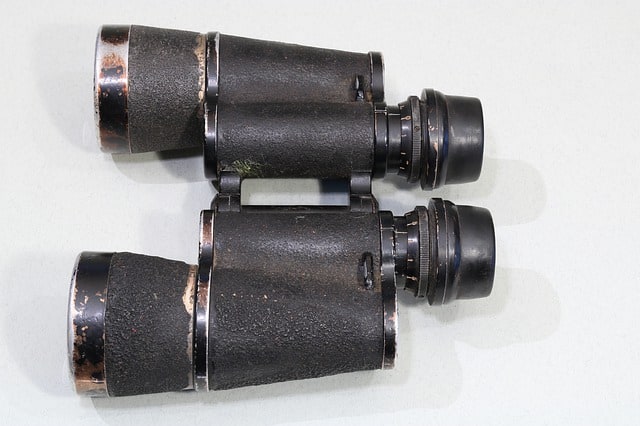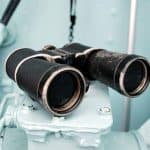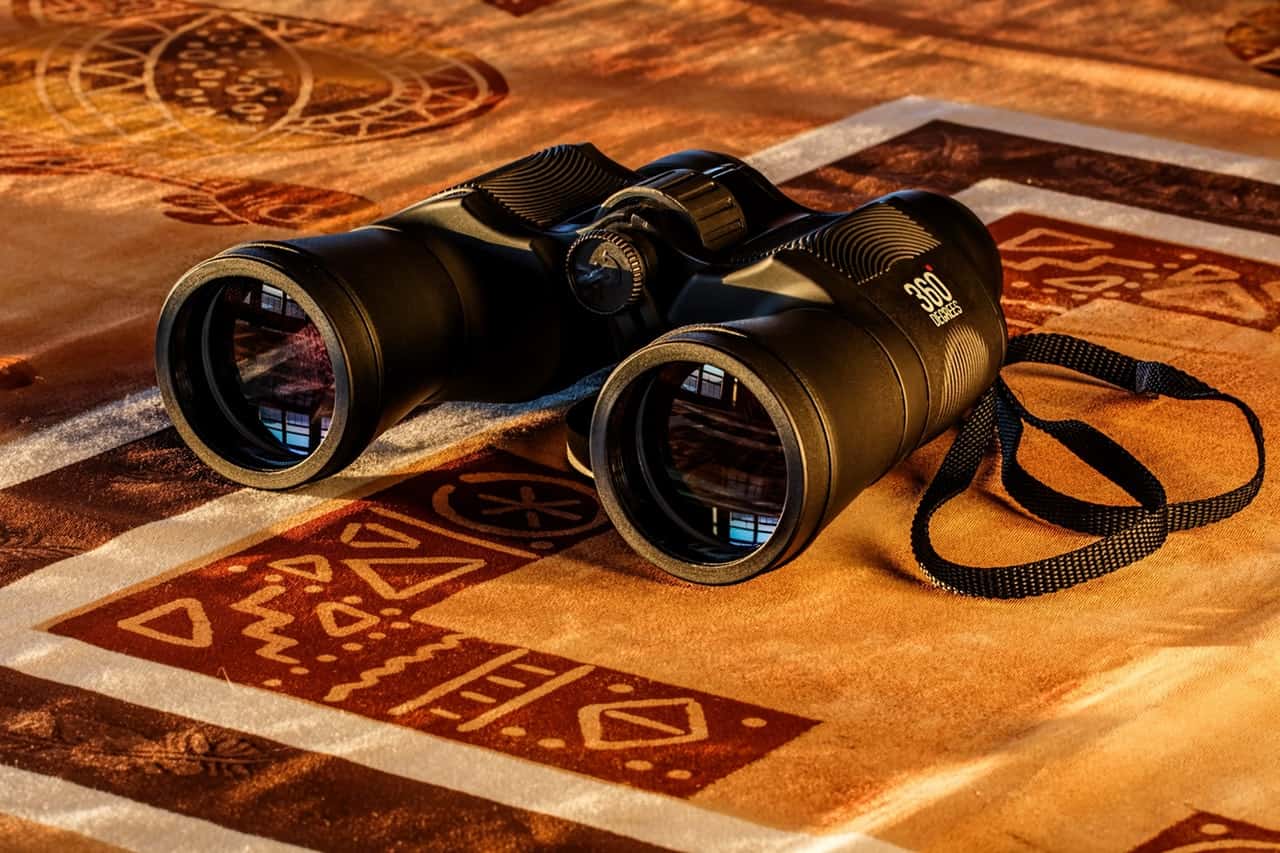Binoculars have been helping hobbyists and military personnel for a long time. When our eyes cannot spot an object, a binocular does the job. Like most other instruments, binoculars have also had their fair share of changes and development over time.
The binoculars we see today serve the same purpose as their predecessors, but their build and mechanics have drastically changed. The lenses and prisms fitted into modern binoculars are highly advanced versions of the antique ones. This evolution in the optics field brings some questions to the limelight; are old binoculars still usable? Are they worth buying, or have the new models completely overtaken the race?
Should I buy used binoculars?
Binocular users are often apprehensive about getting or not getting an old pair due to the same questions. Therefore, I decided to answer most questions about old binoculars (and debunk a few myths while I am at it).
If you’re interested in a pair of vintage binoculars and want to know its worth, keep on reading!
A brief history of binoculars
Binoculars were first invented in 1840 as opera glasses, small and easy-to-hold. Soon after that, more significant binocular models were developed for battles and surveillance purposes; these binos were also hefty and stand-mounted.
Binocular engineers would use a series of lenses to provide you with different magnification levels. But the actual easy-to-use binoculars were designed around 1900 when prisms were associated with lenses for better visual performance.
These initial models weren’t very capable and served primarily as leisure activities. However, when WWI hit the world, optic manufacturers started experimenting with different glass parts and came up with a wide variety of binoculars for armed forces. Optical coatings were introduced during the world wars for better light transmission and controlled reflection.
Even today, we see a broad range of WWI and WWII binoculars that offer incredible visual experience. Unlike most modern gadgets, the binoculars’ design has remained largely unchanged throughout these years. Old binoculars’ magnification isn’t great when compared with the modern ones, but their field of views are exceptional.
With time, new lens carving technologies and prism types surfaced that made binoculars more user-friendly and capable. However, those old binoculars still stand out because of their designs and vintage charm, something not everyone has an eye for.
Also Read: Are Swarovski Binoculars Worth the Money? (& Our Top 3 Picks)
Antique and vintage binoculars: price and value guide
If you want to buy an antique binocular today, it will cost a lot less than new models, mainly because people prefer advanced versions of any gadget. Antique binoculars (if found in a usable condition) are a good bargain, as you can experience an exclusive gadget without spending much.
You can find old binoculars in both antique stores and from online sellers anywhere between $15 to $250. This price difference is because of multiple factors (which we’ll discuss shortly), but the amount you pay mainly depends upon the seller you deal with.
Since the isn’t a set price limit for antique gadgets, you should be careful about it. We recommend you get old binoculars from trusted sellers from eBay, Etsy, or Amazon, as you’ll get good customer service through these platforms. If you’re lucky, you might well find some rare battle-tested binoculars from these places, which are amazing as collectibles.
Old binoculars’ value
Each vintage binocular’s value varies drastically. Some 100-years old binos are still on the market in usable condition, while others might not work that well; the price factor boils down to a binocular’s condition and performance.
-
Condition
Heavily used (and even abused) old binoculars lose their charm, which you can notice by their housing. If a vintage binocular is well taken care of, its chassis doesn’t get distorted, and you don’t need to do much repairing either. Similarly, polished and protected objective lenses perform well for a considerable time, and you have to pay a reasonable price to enjoy them.
Therefore, check your preferred old binocular’s condition and see if the seller’s quoted price is justified. If you get good-quality lenses, the original carry case, and clean binocular housing, you’re on the winning side. But if someone tries to sell a distorted vintage pair of binoculars for above $50, beware.
-
Specs
Old binoculars were larger than those we see today, and some even came with impressive magnification ranges. Check for a binocular’s objective diameter and magnification to determine its value.
The biggest perk of checking vintage binoculars is that you see a vast range of technical specs. You can easily find binos like the 8×60 U-boat, developed specifically for German forces. And if you need a smaller vintage binocular, options like Leitz 7×42 outperform many modern binos with a flick.
Also Read: Are HD Binoculars Better?
-
Maker/brand
Manufacturers impact a binocular’s value and usability. If you pick a random Japan-made vintage binocular and compare it with premium Leitz or Zeiss binos, that’s an unfair equation. Therefore, inquire about an old bino’s manufacturer.
Two significant binocular makers that emerged during WWII were Leitz (now known as Leica) and Zeiss, which created incredible optics for the German military. These brands were the pioneers in making high-quality binoculars, and you can always count on their old binos’ performance.
Apart from these two manufacturers, other German lenses from that era are also par excellence and still cost a reasonable sum. If you find a vintage German binocular in usable condition, don’t miss it.
On that topic, also read our article on the fascinating history of German binoculars during WWII and vintage Carl Zeiss Jena NVA 7×40.How would I test old binoculars?
I would do the following steps when buying a second hand set of binoculars.
1. Inspect the binoculars for any visible damage or signs of wear.
2. Inspect the lenses for any scratches, smears or other signs of damage. This is crucial.
3. Look through the binoculars to make sure that the view is clear and that the image is undistorted.
4. Make sure that the focusing mechanism is working properly – work the controls back and forth a few times.
5. Check the diopter adjustment to make sure that it is working properly and that the image is sharp.
6. Hold the binoculars up to a bright light source and look through them to make sure that there is no light leakage or fogging of the lenses.
7. Take them to a dark area and look through them at a distant object to make sure that the image is bright and clear.
How to identify old binoculars?
Don’t think that any old-looking binocular is actually antique; it might be an excessively used new pair. Check for the official markings on your preferred binoculars, as most old gadgets come with these marks. If you don’t find any marking, check a binocular’s manufacturer, and look up its website to know exactly how old a particular model is.
Another thing that’ll help you identify vintage binoculars is their leather covering. Most old binoculars have attached leather housing, which isn’t very common now.
For your convenience, we have divided old binoculars into two categories:
-
Collectibles
If you aren’t planning to use an old binocular and only need it for showcasing, any binoculars made between 1900 to 1950 will serve the purpose. Most of these binos aren’t very dependable due to excessive usage, and you cannot rely on them for important activities, i.e., hunting. However, since these binos look vintage, they’ll surely enhance your gallery’s aura.
-
Usables
Most of these binoculars are made after 1950 and aren’t excessively used. If you find a Nikon, Swarovski, or Zeiss binocular made in the 70s or 80s, grab it without any doubt. That was the golden era in the optics field, as many new techniques were introduced in that time span. You’ll find good-to-go and dependable vintage binoculars that serve the purpose just right.
Also Read: Are Image Stabilization Binoculars worth the Extra Money? (Our Top 3 Picks)
How to make old binoculars workable?
People who often explore auctions and garage sales would agree that most old gadgets come in awful forms. If a used binocular’s lenses are chipped or cracked, it cannot be fixed unless you find new parts to replace the old ones. But if it has minor issues, you can make an antique binocular work with a little effort.
-
Cleaning
Chipped housing, fungal growth inside the lenses, and dust accumulation are the most frequent issues that come with an old binocular. If you don’t know how to thoroughly clean a binocular, read my quick guide, and find your answer. Also, here are some of the best binocular cleaning kits that’ll ease this pursuit for you. You can preserve an old binocular’s look and make it usable with a regular cleaning regime.
-
Repairing
If you’re facing a double vision problem with a used binocular, don’t worry because it’s fixable. You can either fix this problem at home with proper tools and guidance or contact a reliable binocular repairing service near you. Either way, most lens and prism-related binocular problems can be resolved. Once these glitches are fixed, you can use a vintage binocular in the coming years without much hassle.
Final words
Collecting vintage and valuable gadgets is a rewarding hobby, as you might come across some hidden gems in the heaps of useless stuff. Binoculars have been around for more than 150 years, and their manufacturing standards also keep changing, but nothing beats the class of vintage binoculars.
You can find excellent old binoculars after a little research and experience that vintage charm without spending much. However, make sure that the old binocular you buy has good-quality lenses and prisms because if these parts are damaged, you’ll have a hard time fixing them.
Old binoculars come with different price tags, compare their features, and pick one that justifies the cost. If you find a glass with excellent specs and good form, it’ll be a valuable addition to your gear for sure.
Also Read: Why are Zeiss Binoculars so Expensive? Are They Better than Other Brands?

Binos enthusiast since I was 12 – A real expert in all things optics including rifle scopes and red dots. Live in Dubai & love writing, beaches and eating!






